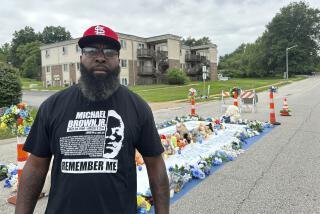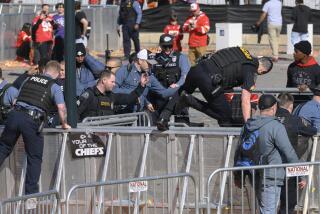Missouri officials call for ‘mutual respect and restraint’ in Ferguson
- Share via
Reporting from St. Louis — Top Missouri officials on Monday afternoon urged St. Louis area residents to maintain the peace as they prepared for a grand jury announcement about whether to charge a white police officer in the shooting of Michael Brown, an unarmed black man in Ferguson.
The announcement of the grand jury action in the fatal shooting by Officer Darren Wilson of Brown was scheduled for 6 p.m. Pacific Standard Time.
“We expect people on all sides to show tolerance, mutual respect and restraint,” Missouri Gov. Jay Nixon told reporters at a late afternoon news conference.
“People need to think with their heads, not their emotions,” St. Louis County Executive Charlie A. Dooley said.
“Our main priority is to keep people safe and protect property,” Dooley said, adding that officials “recognize the right of people to peacefully assemble.
Both officials said they didn’t know what the grand jury announcement would be.
Ferguson police Officer Wilson could face a murder indictment, lesser charges or no charges at all. The St. Louis County grand jury has been hearing testimony and getting evidence for months.
The shooting sparked months of protests in and around Ferguson and reignited a national debate about racial attitudes in the United States and the treatment of black suspects by police and other authorities.
As the announcement of a grand jury decision neared, officials repeatedly called for calm, as did the Brown family and many of their supporters. Missouri Gov. Jay Nixon declared a state of emergency and mobilized the National Guard to help local and state police maintain the peace and to ensure that those protesting are allowed to exercise their 1st Amendment rights.
Witnesses to the shooting have presented different versions of events.
Police said Wilson was driving his police cruiser when he saw Brown with a friend, Dorian Johnson, walking in the street Aug. 9. Wilson confronted Brown and the pair scuffled at the police car, police said. At least one shot was fired in the car, injuring Brown.
Brown, 18, then fled, police said. As Wilson chased Brown, Brown turned around and ran toward Wilson, police said.
“Officer Wilson had his service weapon drawn,” police said in a statement of events. “As the deceased began to run towards him, he discharged his service weapon several times.”
Johnson, however, told a different story.
Wilson used profanity to tell the young men to get out of the street, then hit Brown with his door while trying to open it. Wilson grabbed Brown by the neck, Johnson told reporters.
During the chase, Johnson said, Wilson shot Brown in the back, and Brown stopped, turned with his hands up, and said, “I don’t have a gun. Stop shooting!” Johnson told MSNBC.
Johnson said Wilson, standing face to face with Brown, then shot Brown several times.
The 12 members of the grand jury have been meeting for months in Clayton, Mo., the seat of St. Louis County, which includes Ferguson. This grand jury has one black man, two black women, six white men and three white women.
The proceedings have been secret, but the group heard testimony from Wilson and received at least two autopsies of Brown -- the official autopsy and one carried out by Dr. Michael Baden, the former medical examiner in New York City who was retained by the Brown family.
The grand jury was asked to decide a number of questions that have swirled around the shooting.
What was Wilson doing when he stopped Brown and a friend on a public street? Was there a struggle at the car and what are the details? Did Wilson intentionally kill Brown or was he negligent? Did Wilson use excessive force in firing at least six times to subdue Brown? How far away was Wilson when he fired the fatal shot? Were Brown’s hands up or down? Did Wilson fire out of fear for his life or that Brown would commit violence against others?
The most serious charge Wilson could face is second-degree murder, which includes the idea of “knowingly causing” death; it is punishable by a prison term of 10 to 30 years. Next is voluntary manslaughter, which means causing a death under the influence of some sort of passion; it carries a penalty of five to 15 years.
There are two involuntary manslaughter charges possible: First-degree involuntary manslaughter involves recklessly causing a death; second-degree is based on criminal negligence in the death.
The jurors probably weighed whether Wilson acted within the rules for law enforcement officers that allow for the use of violence when there is a reasonable belief the suspect will inflict serious harm or if the officer reasonably believes force is needed to prevent death or serious injury.
Almost as controversial as Brown’s death was the intimidating police response by the St. Louis County Police Department and other agencies, which cleared the streets of protesters in the following week with rubber bullets and tear gas.
More to Read
Sign up for Essential California
The most important California stories and recommendations in your inbox every morning.
You may occasionally receive promotional content from the Los Angeles Times.













